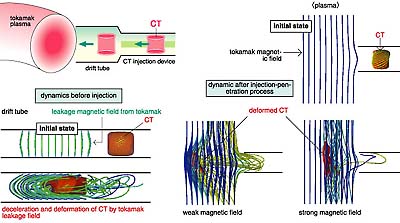 This picture, (126KB) |
||
|
| Compact torus (CT) plasma injection into a target plasma has drawn considerable attention as an effective method of fueling core plasmas of a fusion reactor. The CT plasma is a toroidally-shaped magnetized lump of plasma (plasmoid), or a micro-sized tokamak-like plasma produced by a coaxial plasma gun equipped with a magnetization coil. Scenarios such as high speed injection of a CT to supply fuel plasma deep at the reactor core, or acceleration-controlled injection of a CT to an arbitrarily localized region in the plasma to control burning etc. will be available, and experimental studies to develop the feasibility of CT injection are under way on JFT-2M and other medium-sized tokamaks. However the physical behavior of injected CT in a tokamak plasma and the effectiveness of fueling by CT have not yet been fully understood. We have made a detailed investigation of; the dynamics of a CT plasma in a magnetized plasma, and a theoretical model of tokamak core plasmas involving the injection and penetration processes and the deceleration mechanism of CT plasma by three dimen-sional magnetohydrodynamic simulations (Fig. 2-11). We have found the following so far; (1) An injected CT plasma goes through complicated interactions with a simulated tokamak magnetic field, resulting in magnetic reconnection, and the magnetic field is transformed into a new-configuration. As a result the CT plasma loses its entity as a plasmoid and the high density CT plasma mixes with the background tokamak plasma, and thus fueling is done. (2) Deceleration of a CT plasma is caused not only by the pressure of the tokamak magnetic field but also by the tension of its magnetic lines of force. (3) Magnetic reconnection has a relaxation effect on the deceleration process due to the magnetic tension of lines of force. Further studies including comparison with experimental results will be continued. |
| Reference Y. Suzuki* et al., Three-Dimensional Dynamics of a Compact Torus Injected into Magnetized Plasmas II, Purazuma, Kaku Yugo Gakkai-shi, 76(3), 288 (2000). *post doctoral fellow |
| Select a topic in left column |
|
Persistent Quest-Research Activities 2000 Copyright(c)Japan Atomic Energy Research Institute |